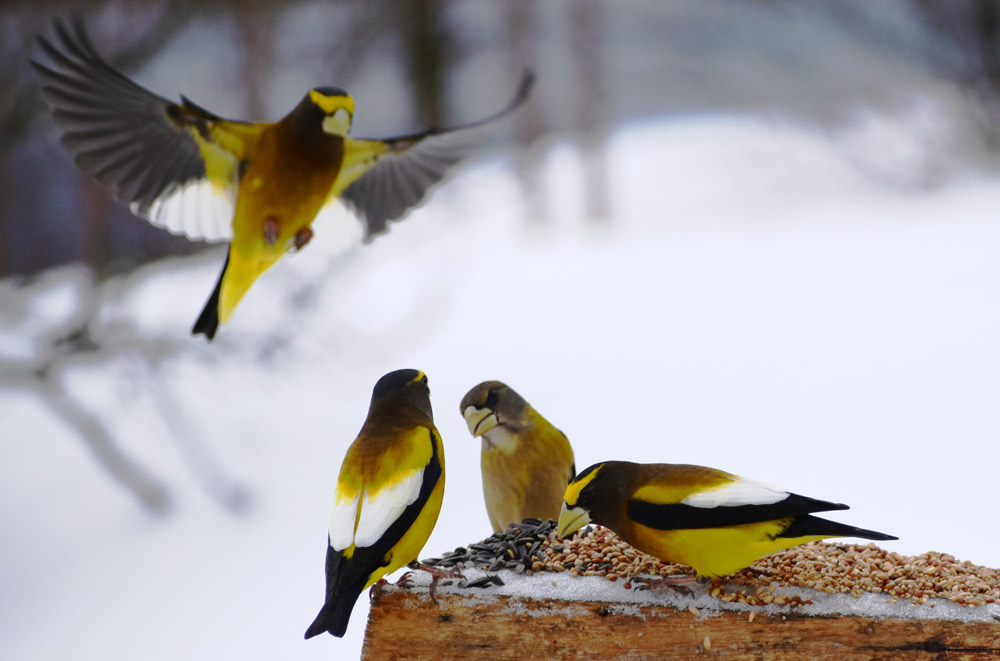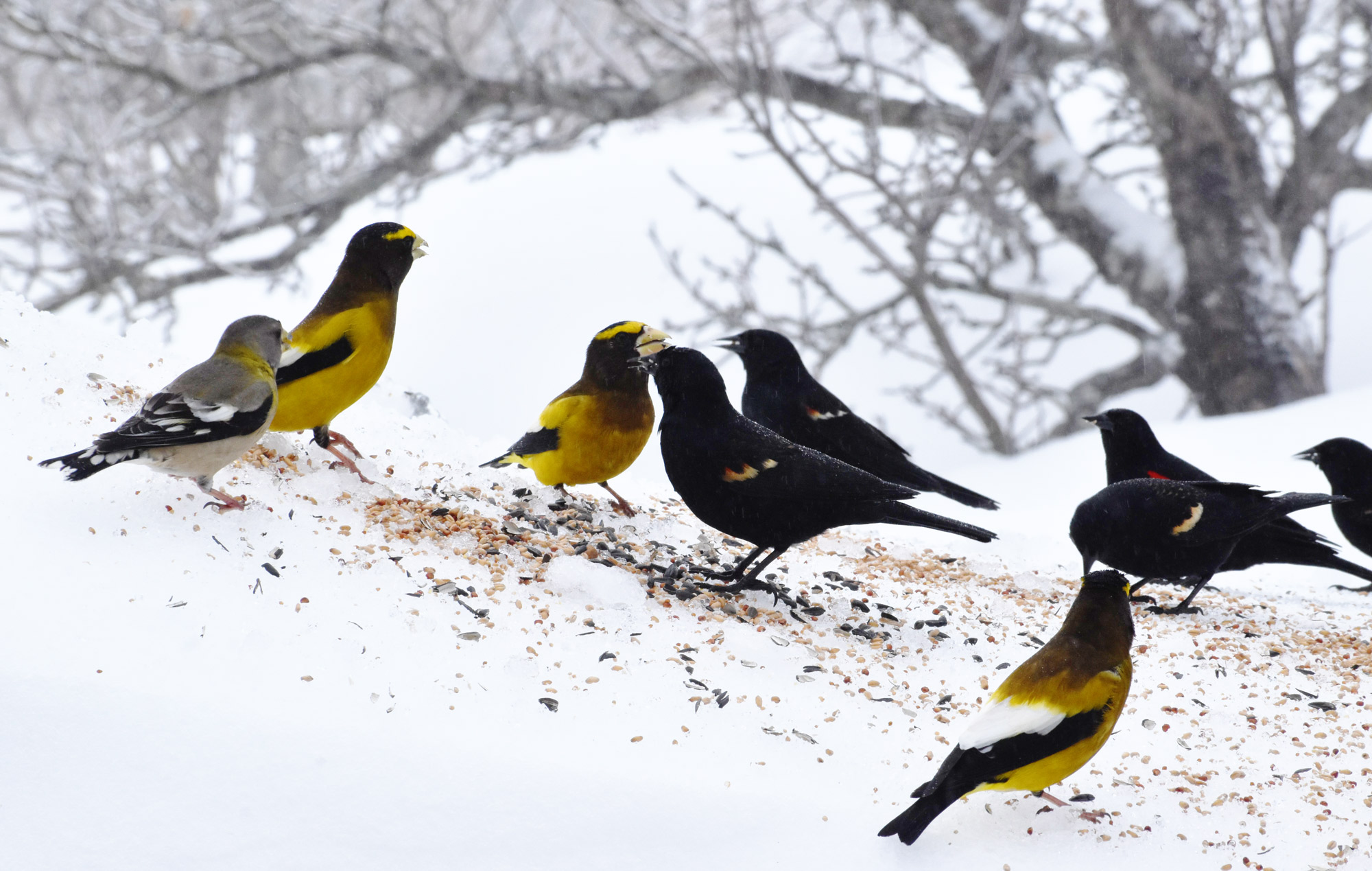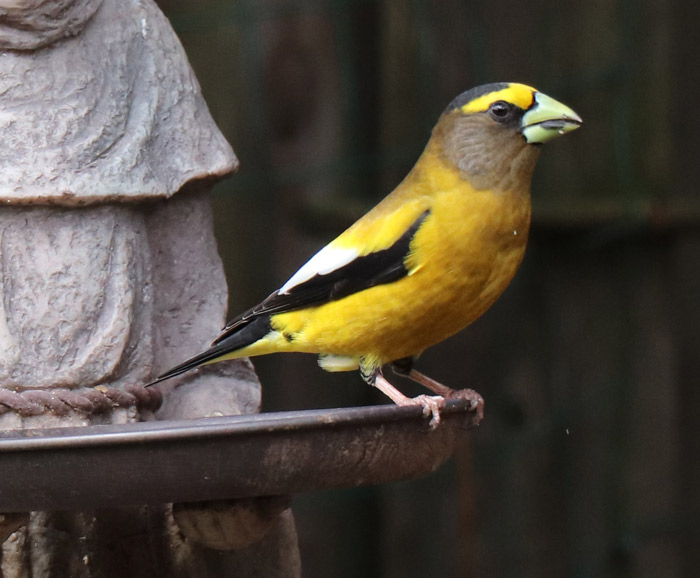EVENING GROSBEAK, RANGE, SONG, IMAGES, HABITAT, DIET, FEMALE, MALE, MIGRATION, FACTS, CONSERVATION

The Evening Grosbeak (Coccothraustes vespertinus) is a species of finch that is known for its striking appearance and beautiful song.
LOCATION
To begin with, these birds are native to North America and are typically found in coniferous forests and woodlands in the northern and western parts of the continent.
COLORS
The most distinctive feature of the Evening Grosbeak is its colorful plumage. The males have bright yellow heads and breasts, with black backs and wings.
In contrast, the females are more subdued in color, with a grayish-brown head and breast and a streaked back and wings. Both sexes have a large, conical bill that is well-suited for cracking open seeds.
SOCIAL BIRDS
Evening Grosbeaks are highly social birds and are often seen in large flocks. They are also quite vocal, and their song is a loud, melodic series of whistles and trills. These birds are also known to mimic the songs of other birds.
DIET
One of the most interesting things about Evening Grosbeaks is their diet. In fact, they are primarily seed-eaters, and they are known to consume large quantities of sunflower seeds. To finish, they are also known to eat fruits and insects and are particularly fond of suet.

REPRODUCTION
In terms of breeding, Evening Grosbeaks typically breed in the spring and early summer. The females build the nest, which is a large, bulky structure made of twigs and lined with moss.
The females lay between 2 and 6 eggs, which they incubate for about two weeks. Both parents help to feed and care for the young.
COMMON BIRD
Evening Grosbeaks are a common and widespread species in North America, and their populations appear to be stable.
However, their numbers have decreased in some areas due to habitat destruction and fragmentation. Due to this, conservation efforts have been implemented to protect and manage this beautiful bird.
ECOSYSTEM
In addition to their beauty, Evening Grosbeaks are also important to the ecosystem. They play a role in seed dispersal and pollination, helping to ensure the survival of the plants they consume. They are also an important food source for predators such as hawks and owls.
ADAPTATION
To pursue, they are also known for their hardiness. They can survive harsh winters and cold temperatures, which allows them to thrive in their northern and western range.
They are also able to adapt to different types of habitats, including suburban and urban areas if there are food sources available.

URBANIZATION
Despite their hardiness, Evening Grosbeaks are still affected by human activities. For instance, habitat loss and fragmentation can limit their breeding and feeding grounds, which can negatively impact their population.
They are also vulnerable to pesticide exposure, which can harm their health and reproductive success.
HOW TO PROTECT EVENING GROSBEAKS?
To protect Grosbeaks, conservation efforts should focus on preserving and restoring their natural habitats, particularly coniferous forests, and woodlands.
For example, this can be done through reforestation and conservation of existing forests, as well as the creation of wildlife corridors to connect fragmented habitats.
Indeed, efforts should also be made to minimize pesticide use and protect against pollution in their habitats.
MONITORING POPULATION
Another important aspect of protecting Evening Grosbeaks is monitoring their population.
Regular surveys and monitoring of the population can help identify any declines or changes in distribution, which can inform conservation efforts.
There are as well citizen science programs, where members of the public report observations of Evening Grosbeaks, which can also be valuable in monitoring population trends.

RAISING AWARENESS
Another way to help this bird is through education and awareness raising. For instance, by educating the public about the importance of Evening Grosbeaks and their habitats, we can inspire more people to take action to protect them.
It could include supporting conservation efforts, reducing pesticide use, and creating bird-friendly habitats in urban and suburban areas.
CLIMATE CHANGE IMPACT
In addition, it is important to consider the impacts of climate change on Evening Grosbeaks. As the climate changes, the distribution and abundance of their food sources may shift, which could impact their population.
Therefore, conservation efforts should consider how they might be affected by climate change and take steps to mitigate any negative impacts.
MIGRATION ROUTES
One important element of Evening Grosbeak conservation is the protection of their migration routes. In fact, many Evening Grosbeaks migrate long distances between their breeding and wintering grounds, and these migration routes are essential for their survival.
However, many of these routes are also threatened by human activities such as habitat destruction, pollution, and climate change.
To protect them during their migration, conservation efforts should focus on preserving and restoring habitats along their migration routes, as well as reducing the threats of pollution and climate change.
IMPORTANCE OF FOREST
It’s also important to note that the Yellow Grosbeak is not the only species that depend on coniferous forests and woodlands. It shares its habitat with many other species of birds, mammals, and plants, which also play an important role in the ecosystem.
Then, conservation efforts to protect the Evening Grosbeak should also consider the needs of these other species. This can be done by implementing conservation strategies that promote the health and biodiversity of these habitats.

MUTUALISTIC RELATIONSHIP WITH TREES
In addition, the conservation of the Evening Grosbeak should also consider its relationship with other species. Evening Grosbeaks are known to have a mutualistic relationship with certain species of trees, such as the white spruce, which they consume its seeds.
That’s why the conservation of the white spruce and other species that the Evening Grosbeak depends on should also be considered.
WINTERING GROUNDS
One final component of Evening Grosbeak conservation is the protection of their wintering grounds. Many Evening Grosbeaks migrate south to spend the winter in warmer regions, where they rely on specific habitats to survive.
Unfortunately, these habitats are often threatened by human activities such as deforestation, agriculture expansion, and urbanization.
FOOD SOURCES THREAT
It is also important to consider the impacts of human activities on the Evening Grosbeak’s food sources during the winter.
It’s known that many Evening Grosbeaks rely on natural food sources such as seeds and fruits to survive, but these resources can be impacted by human activities such as deforestation, agriculture expansion, and urbanization.
To ensure that Evening Grosbeaks have enough food to survive the winter, conservation efforts should focus on protecting and restoring natural food sources in their wintering grounds.
RESEARCH
For their conservation, it’s important to research and monitors the Evening Grosbeak population. By studying the behavior, ecology, and population trends of Evening Grosbeaks, scientists can better understand the threats they face and develop effective conservation strategies.
Indeed, this research can also help to identify any unique or specific conservation needs of the Evening Grosbeak.
In conclusion, the Evening Grosbeak is a beautiful and important bird that requires conservation efforts to protect it. Habitat preservation and restoration, reducing pesticide use, monitoring population trends, protecting migration routes, promoting biodiversity, and protecting their wintering grounds are all important steps in ensuring the survival of this species. Additionally, conservation efforts should consider the relationship between the Evening Grosbeak and other species that it depends on, such as certain trees, and the impact of human activities on food sources. By working together, we can ensure that this beautiful bird continues to thrive in the wild.
WANT TO LEARN MORE? TAKE A LOOK AT THESE ARTICLES:
- The Scarlet Macaw
- The Scarlet Ibis
- Lovebirds
- The Female Cardinal
- The Great Egret
- The Great Blue Heron
- The American Robin
- The Northern Cardinal
- The Dark-Eyed Junco
- The Blue Jay
- The Gray Catbird
- The Tufted Titmouse
- The Red-winged Blackbird
- The Black-capped Chickadee
- The Evening Grosbeak
- The Common Starling
- The Kiwi Bird
- Wild Birds Unlimited

